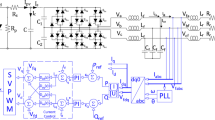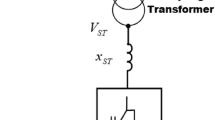Abstract
This paper presents a decentralized synergetic power system stabilizer (DSPSS). The nonlinear control law was synthesized by introduction of invariant manifolds into the state space of studied system, synchronous machine connected to infinite bus. The invariant manifold was defined as a linear combination of the generator terminal voltage, rotor speed and active power deviation to achieve coordination of the synchronous generator electromechanical oscillation damping and terminal voltage control. Compared to other synergetic power system stabilizers, this one uses real time Park’s transformation to calculate dq-components of generator currents and voltages. Also, a novel approach for calculation of a generator voltage derivative is presented, and the proposed stabilizer is less sensitive to sudden voltage changes and measurement noise. DSPSS control law was implemented on real-time hardware platform and experimentally tested on an 83kVA synchronous hydrogenerator. Experimental results for the power and voltage reference step change, loss of the transmission line and three phase short circuit were conducted using DSPSS and PSS2A stabilizers. Furthermore, the results showed that the proposed DSPSS stabilizer was robust to system parameter changes and has better dynamic response than the classic PSS2A in case of small and large disturbances.








Similar content being viewed by others
References
Bayod-Rújula AA (2009) Future development of the electricity systems with distributed generation. Energy 34(3):377–383. doi:10.1016/j.energy.2008.12.008
Lior N (2012) Sustainable energy development: The present (2011) situation and possible paths to the future. Energy 43(1):174–191. doi:10.1016/j.energy.2011.11.038
Kundur P, Balu NJ, Lauby MG (1994) Power system stability and control, vol 7. McGraw-hill, New York
Machowski J, Bialek J, Bumby J (2011) Power system dynamics: stability and control. John Wiley & Sons,
Andersson G, Donalek P, Farmer R, Hatziargyriou N, Kamwa I, Kundur P, Martins N, Paserba J, Pourbeik P, Sanchez-Gasca J, Schulz R, Stankovic A, Taylor C, Vittal V (2005) Causes of the 2003 major grid blackouts in North America and Europe, and recommended means to improve system dynamic performance. IEEE Transactions on Power Systems 20(4):1922–1928. doi:10.1109/TPWRS.2005.857942
Larsen E, Swann D (1981) Applying power system stabilizers part i, ii and iii, Power Apparatus and Systems. IEEE Transactions on PAS 100(6):3017–3024. doi:10.1109/TPAS.1981.316355
Sumina D, Bulić N, Mišković M (2011) Parameter tuning of power system stabilizer using eigenvalue sensitivity. Electric Power Systems Research 81(12):2171–2177. doi:10.1016/j.epsr.2011.07.016
Chen G, Sun Y, Cheng L, Lin J, Zhao W, Lin C (2012) A novel PSS-online re-tuning method. Electric Power Systems Research 91:87–94. doi:10.1016/j.epsr.2012.05.013
Kumar A (2016) Power System Stabilizers Design for Multimachine Power Systems Using Local Measurements. IEEE Transactions on Power Systems 31(3):2163–2171. doi:10.1109/TPWRS.2015.2460260
Perić VS, Sarić AT, Grabež DI (2012) Coordinated tuning of power system stabilizers based on Fourier Transform and neural networks. Electric Power Systems Research 88:78–88. doi:10.1016/j.epsr.2012.01.017
Keumarsi V, Simab M, Shahgholian G (2014) An integrated approach for optimal placement and tuning of power system stabilizer in multi-machine systems. International Journal of Electrical Power & Energy Systems 63:132–139. doi:10.1016/j.ijepes.2014.05.072
Sun Z, Wang N, Srinivasan D, Bi Y (2014) Optimal tunning of type-2 fuzzy logic power system stabilizer based on differential evolution algorithm. International Journal of Electrical Power & Energy Systems 62:19–28. doi:10.1016/j.ijepes.2014.04.022
Zhu C, Zhou R, Wang Y (1997) A new nonlinear voltage controller for power systems. International Journal of Electrical Power & Energy Systems 19(1):19–27. doi:10.1016/S0142-0615(96)00022-1
Guo Y, Hill D, Wang Y (2001) Global transient stability and voltage regulation for power systems. IEEE Transactions on Power Systems 16(4):678–688. doi:10.1109/59.962413
Kenné G, Goma R, Nkwawo H, Lamnabhi-Lagarrigue F, Arzandé A, Vannier JC (2010) An improved direct feedback linearization technique for transient stability enhancement and voltage regulation of power generators. International Journal of Electrical Power & Energy Systems 32(7):809–816. doi:10.1016/j.ijepes.2010.01.018
Leon AE, Mauricio JM, Solsona JA (2012) Multi-machine power system stability improvement using an observer-based nonlinear controller. Electric Power Systems Research 89:204–214. doi:10.1016/j.epsr.2012.01.022
Bazanella A, Kokotovic P, e Silva A (1999) A dynamic extension for LgV controllers. IEEE Transactions on Automatic Control 44(3):588–592. doi:10.1109/9.751357
Machowski J, Robak S, Bialek J, Bumby J, Abi-Samra N (2000) Decentralized stability-enhancing control of synchronous generator. IEEE Transactions on Power Systems 15(4):1336–1344. doi:10.1109/59.898110
Galaz M, Ortega R, Bazanella AS, Stankovic AM (2003) An energy-shaping approach to the design of excitation control of synchronous generators. Automatica 39(1):111–119. doi:10.1016/S0005-1098(02)00177-2
Erceg I, Sumina D, Tusun S, Kutija M (2017) Power system stabilizer based on pointwise min-norm control law. Electric Power Systems Research 143:215–224. doi:10.1016/j.epsr.2016.10.014
Kuz’menko AA (2011) Nonlinear adaptive control of a turbogenerator. Journal of Computer and Systems Sciences International 47(1):103–110. doi:10.1134/S1064230708010139
Jiang Z (2009) Design of a nonlinear power system stabilizer using synergetic control theory. Electric Power Systems Research 79(6):855–862. doi:10.1016/j.epsr.2008.11.006
Bouchama Z, Harmas MN (2012) Optimal robust adaptive fuzzy synergetic power system stabilizer design. Electric Power Systems Research 83(1):170–175. doi:10.1016/j.epsr.2011.11.003
Nechadi E, Harmas MN, Hamzaoui A, Essounbouli N (2012) Type-2 fuzzy based adaptive synergetic power system control. Electric Power Systems Research 88:9–15. doi:10.1016/j.epsr.2012.01.009
Ademoye T, Feliachi A, (2011) Decentralized synergetic control of multimachine systems, in: Power Systems Conference and Exposition (PSCE), 2011 IEEE/PES, pp. 1–8. doi:10.1109/PSCE.2011.5772526
Zhao P, Yao W, Wen J, Jiang L, Wang S, Cheng S (2015) Improved synergetic excitation control for transient stability enhancement and voltage regulation of power systems. International Journal of Electrical Power & Energy Systems 68:44–51. doi:10.1016/j.ijepes.2014.12.056
Leon AE, Solsona JA, Valla MI (2012) Comparison among nonlinear excitation control strategies used for damping power system oscillations. Energy Conversion and Management 53(1):55–67. doi:10.1016/j.enconman.2011.08.010
Kolesnikov A, Veselov G, et al. (2000) Modern applied control theory: synergetic approach in control theory, In: TRTU, Moscow, Taganrog
Kolesnikov AA (2009) Nonlinear system’s synthesis–the central problem of modern science and technology: Synergetics conception. part ii: Strategies of synergetics control, In: Proc. of CHAOS2009 Conference
Kolesnikov A (2014) Introduction of synergetic control, in: American Control Conference (ACC), 2014, pp. 3013–3016. doi:10.1109/ACC.2014.6859397
Santi E, Monti A, Li D, Proddutur K, Dougal R (2003) Synergetic control for DC-DC boost converter: implementation options. IEEE Transactions on Industry Applications 39(6):1803–1813. doi:10.1109/TIA.2003.818967
Kondratiev I, Santi E, Dougal R, Veselov G (2004)Synergetic control for m-parallel connected DC-DC buck converters, in: Power Electronics Specialists Conference, 2004. PESC 04. 2004 IEEE 35th Annual, Vol. 1, pp. 182–188 Vol.1. doi:10.1109/PESC.2004.1355739
Tusun S, Erceg I, Sirotić I (2016) Laboratory model for design and verification of synchronous generator excitation control algorithms, In: 2016 39th International Convention on Information and Communication Technology. Electronics and Microelectronics (MIPRO) 2016:146–151. doi:10.1109/MIPRO.2016.7522128
IEEE recommended practice for excitation system models for power system stability studies, IEEE Std 421.5-2005 (Revision of IEEE Std 421.5-1992) 0_1–85 doi:10.1109/IEEESTD.2006.99499
Author information
Authors and Affiliations
Corresponding author
Appendix: Laboratory model parameters
Appendix: Laboratory model parameters
The laboratory model consists of a synchronous generator (83 kVA) which is connected to the grid through two connection lines and a transformer. The generator is mechanically coupled with two 44kW DC motors (Fig. 7).
DC motors are powered from the SIEMENS Simoreg DC-Master converter (Fig. 8 left) while the generator excitation is power from the IGBT DC converter (Fig. 8 right).
The generator and system parameters are given in Tables 5 and 6, respectively. The voltage and current controller parameters are in Table 7. From the frequency characteristic of the generator system, using the classical linear technique the PSS2A has been tuned (Table 8). The structure and parameters’ meaning are given in [34]. Parameters of the DSPSS are in Table 9.
Rights and permissions
About this article
Cite this article
Tusun, S., Erceg, I., Mehmedović, M. et al. Decentralized Synergetic Power System Stabilizer. Electr Eng 100, 311–320 (2018). https://doi.org/10.1007/s00202-016-0506-y
Received:
Accepted:
Published:
Issue Date:
DOI: https://doi.org/10.1007/s00202-016-0506-y




